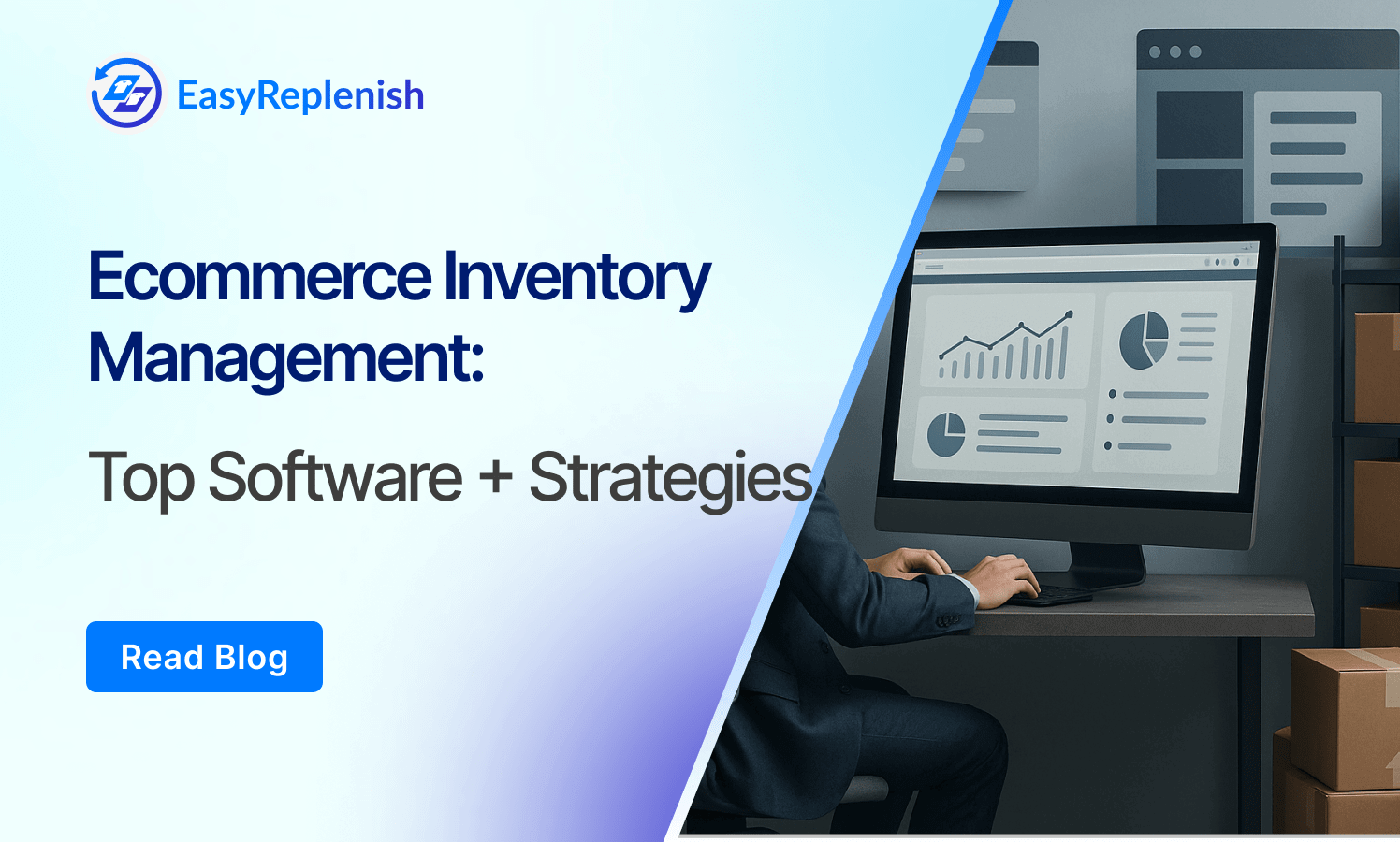Complete Guide to Multichannel Inventory Management

Inventory management has become significantly more complex with the rise of multichannel commerce. Brands today aren’t just selling on their own D2C websites—they’re also operating across online marketplaces like Amazon and Flipkart, offline retail stores, wholesale partners, and sometimes even pop-up events or social commerce platforms. Each of these channels has its own demand patterns, fulfillment workflows, and service-level expectations.
Multichannel inventory management is about gaining real-time visibility, control, and precision across all those sales channels. Without a centralized strategy, stockouts, overstocking, fulfillment delays, and lost sales become inevitable. This guide breaks down exactly what multichannel inventory management is, the challenges it poses, how to implement a system that scales, and how tools like EasyReplenish can help simplify complex inventory operations.
What Is Multichannel Inventory Management?
Multichannel inventory management refers to the process of tracking, controlling, and replenishing inventory across multiple sales channels from a single, integrated system. This includes D2C websites, online marketplaces, physical retail outlets, distributor networks, and third-party logistics (3PL) or fulfillment partners.
Unlike single-channel inventory setups—where stock is managed for one platform—multichannel systems must keep inventory synchronized in real time across all active locations. That means if a unit sells on your Shopify store, the inventory should immediately update on Amazon, in-store POS systems, and internal fulfillment dashboards to avoid overselling.
Effective multichannel inventory management ensures:
- Accurate stock levels across every channel
- Smart allocation and prioritization of inventory by channel
- Automated replenishment based on channel-specific sales velocity
- Unified visibility for planners and fulfillment teams
It’s a foundational capability for any growing retail or D2C brand aiming to scale without sacrificing availability, efficiency, or customer experience.
Core Challenges of Managing Inventory Across Multiple Channels
While multichannel selling opens up new growth opportunities, it introduces serious complexity on the backend. Without a strong inventory management system in place, brands face risks that can directly impact customer experience, fulfillment accuracy, and working capital efficiency. Below are the most common and costly challenges.
1. Lack of Real-Time Inventory Visibility
When stock levels aren’t updated instantly across all channels, overselling and duplicate orders become inevitable. This disconnect leads to canceled orders, poor customer experience, and loss of trust—especially on fast-paced platforms like marketplaces where fulfillment SLAs are strict.
2. Overselling or Stockouts
With disconnected systems, two or more channels may show the same inventory available at the same time. If orders flood in simultaneously, stockouts occur and fulfillment teams scramble. On the flip side, brands may block inventory from other channels “just in case,” resulting in underutilized stock.
3. Channel-Specific Fulfillment Rules
Each channel may require different packaging, shipping timelines, or documentation. Managing these nuances manually across multiple channels increases the risk of errors, delays, and SLA breaches.
4. Complex Returns and Restocking
When orders are returned across multiple channels, brands struggle to track what gets restocked, scrapped, or lost. Without proper integration, returns don’t sync with inventory in real time—leading to ghost stock and inaccurate availability.
5. Data Fragmentation and Disconnected Systems
Many brands use separate tools for e-commerce, POS, ERP, and warehouse operations. Without a centralized platform or integration layer, decision-makers can’t get a unified picture of what’s available, what’s committed, and what needs to be replenished by location or channel.
Tackling these challenges requires not just tools, but a strategic system that ensures channel-level accuracy, real-time syncing, and intelligent replenishment. The next section breaks down the core components of that system.
Key Components of an Effective Multichannel Inventory Strategy
Successfully managing inventory across multiple channels requires more than just syncing stock levels. It demands a system that unifies your supply chain logic, adapts to each channel’s demand behavior, and allows for accurate, real-time planning. Below are the foundational components that make up an effective multichannel inventory strategy.
1. Centralized Inventory Control
At the heart of multichannel inventory management is a centralized system that serves as the single source of truth. It tracks inventory across warehouses, retail stores, 3PLs, and marketplaces. Centralization prevents fragmentation and ensures that every channel reflects accurate, real-time stock availability.
2. Real-Time Stock Visibility Across Channels
Stock movements—whether from sales, returns, transfers, or replenishment—must reflect immediately across all sales channels. Real-time visibility allows planners to avoid overselling, automate reorder triggers, and make allocation decisions faster, especially during high-volume periods.
3. Automated Replenishment by Channel
Replenishment logic must adapt to each channel's unique sales pattern, fulfillment timelines, and demand volatility. The system should automatically trigger reorder recommendations based on forecasted demand, days of cover, or stock thresholds specific to each channel.
4. Channel-Level Buffer Stock and Allocation Rules
A generic stock policy won’t work across every channel. Some platforms require higher safety buffers due to strict delivery timelines or longer lead times. Advanced systems allow brands to define channel-level buffer logic, holdback rules, and allocation prioritization—so key accounts or high-converting platforms never run dry.
5. Integration with WMS, POS, and OMS
To function effectively, your inventory system must connect seamlessly with your Warehouse Management System (WMS), Point of Sale (POS), and Order Management System (OMS). These integrations ensure accurate order routing, prevent double-booking of inventory, and enable visibility from the moment stock is received to when it’s fulfilled.
How to Set Up a Multichannel Inventory Management System
Building a scalable multichannel inventory system isn’t just about plugging in software — it requires aligning processes, data, and tools to ensure inventory accuracy across all sales and fulfillment points. Here’s a breakdown of how to set up an effective system from the ground up.
1. Map All Sales and Fulfillment Channels
Start by listing every active and planned sales channel — including your D2C store, marketplaces like Amazon, retail locations, distributors, and any offline or B2B channels. Also map where inventory is stored: warehouses, 3PLs, retail backrooms, or drop-ship vendors. This mapping gives clarity on how many nodes need to be connected and monitored.
2. Standardize SKUs and Catalog Structures
Inventory accuracy begins with consistent product identification. Ensure all SKUs and variants (size, color, bundle types) are standardized across systems. Mismatched or duplicated SKUs across Shopify, Amazon, or POS systems lead to sync issues, incorrect reporting, and poor allocation logic.
3. Choose the Right Multichannel Inventory Platform
Pick a platform that can centralize inventory across your ecosystem. It should support real-time syncing, intelligent reorder logic, and integrations with your key tools (WMS, POS, ERP, OMS, etc.). Look for features like channel-level stock allocation, virtual bundles, and automated backorder handling.
4. Set Up Inventory Allocation Rules
Decide how you want to allocate available inventory across channels:
- Do you split inventory equally across Amazon, retail, and D2C?
- Do you prioritize high-margin or high-velocity channels?
- Will you reserve a buffer for wholesale or offline partners?
Define these rules clearly inside your system to avoid overcommitment or channel conflict.
5. Automate Replenishment Based on Channel Behavior
Configure replenishment triggers for each SKU based on real-time demand trends by channel. Fast-moving products on Amazon may require more frequent restocking than items sold in-store. Set reorder points, days of cover, or forecast-driven rules that reflect actual channel behavior.
6. Integrate Returns and Restocking Workflows
Returns should automatically reflect in your inventory counts once processed. Ensure your system handles restocking logic — whether returned items go back into sellable inventory, are scrapped, or require inspection — and updates all relevant channels accordingly.
Once these elements are live, your system can act as a centralized control tower—giving visibility, control, and replenishment intelligence across your full multichannel operation.
Best Practices for Inventory Allocation Across Channels
Multichannel success depends not only on having enough stock but also on how that stock is distributed. Poor allocation can lead to stockouts in high-performing channels and overstock in low-performing ones. Here are best practices to ensure inventory is allocated effectively across your sales ecosystem.
1. Prioritize Channels Based on Profitability or SLA
Not all channels contribute equally to your bottom line. Assign inventory priority based on:
- Margin: D2C or owned channels often yield higher margins than marketplaces or wholesale.
- SLA Risk: Some platforms (like Amazon FBA) penalize missed fulfillment deadlines.
- Strategic Importance: Retail partners or flagship locations may require consistent stock.
By setting priority rules, you ensure inventory is first committed to your most valuable or risky channels.
2. Use Shared Pool vs. Split Allocation Intelligently
A shared inventory pool works well for low-volume or long-tail SKUs, letting all channels draw from the same stock. For high-volume, high-velocity SKUs, splitting inventory by channel reduces the risk of overselling and ensures critical availability where it matters most.
3. Set Channel-Specific Buffer Stock
Buffer stock requirements vary by channel. You may want a larger buffer for Amazon (due to penalties for stockouts) versus your own site where you control the messaging. Set channel-specific reorder points or days of cover based on historical volatility, lead time, and expected demand spikes.
4. Align Inventory with Marketing and Sales Campaigns
Inventory allocation should reflect upcoming channel-level promotions, influencer campaigns, or seasonality. If a flash sale is planned on your D2C store, pre-allocate inventory accordingly to avoid overselling across marketplaces or retail POS.
5. Geo-Based Allocation for Faster Fulfillment
For brands using regional fulfillment centers or micro-warehouses, allocate inventory based on demand clusters. If most Amazon orders come from the East Coast, stock heavier there to reduce last-mile cost and delivery times—while still keeping enough inventory for other zones or channels.
How Forecasting Differs in Multichannel Inventory Management
Forecasting becomes significantly more complex in a multichannel environment. Unlike single-channel operations, where one demand signal drives replenishment, multichannel setups must handle fragmented, often unpredictable demand across platforms, regions, and fulfillment nodes.
1. Channel-Specific Demand Patterns
Each channel behaves differently. D2C websites may see consistent sales driven by owned marketing, while marketplaces like Amazon or Flipkart often experience spikes due to algorithmic exposure or flash sales. Retail stores might show weekend-heavy demand, while wholesale orders are lumpy but high volume. A single forecasting model cannot accommodate all these patterns equally.
2. SKU Performance Varies by Channel
A SKU that’s a top seller on your online store might underperform in retail due to differences in shopper behavior or merchandising. Effective multichannel forecasting segments demand by SKU-channel combination, allowing businesses to plan replenishment based on actual performance within each distribution point.
3. Overlapping Demand and Inventory Leakage
Without accurate forecasting, brands often double-count demand or fail to account for cross-channel cannibalization. For example, a new launch promoted on Instagram may pull traffic to both your website and your Amazon store—if both channels get stocked equally, one may overstock while the other sells out. Demand forecasts need to reflect channel overlap, attribution, and coordinated campaign planning.
4. Forecasting Inputs Should Include Channel Metadata
High-performing inventory platforms like EasyReplenish allow businesses to forecast with inputs such as:
- Channel-specific seasonality
- Return rates by channel
- Fulfillment lead time differences
- Marketing calendar per channel
- Geo-level demand segmentation
Integrating these inputs ensures more accurate forecasting at the micro level, preventing stockouts in fast-moving channels and reducing excess inventory in slower ones.
Building a Replenishment Strategy for Multichannel Operations
Multichannel selling demands a shift from static, centralized replenishment to a dynamic, channel-aware approach. Each node—whether a warehouse, retail store, or fulfillment center—requires inventory based on its unique demand behavior and constraints. A smart replenishment strategy ensures you keep the right stock in the right place, without overcapitalizing on inventory.
1. Set Replenishment Frequency by Channel
Different channels require different replenishment rhythms. Retail stores may restock weekly based on in-store sell-through, while marketplaces demand faster restocking due to shorter lead times and fulfillment penalties. Your system should allow for flexible replenishment cycles based on historical velocity, forecast accuracy, and fulfillment SLAs.
2. Factor in Channel-Level Lead Times
Lead times vary not just by supplier but also by channel. For example, replenishing a retail store may take 2 days from a local warehouse, but restocking Amazon FBA may require a 7-day lead window plus appointment scheduling. Your reorder logic must factor in lead time per channel-location to avoid late shipments or empty shelves.
3. Account for Inventory Transfers Between Nodes
When stock is shared across locations (e.g., DC to store, or store-to-store), your replenishment strategy must include transfer logic. This reduces reliance on fresh POs and lets you rebalance inventory dynamically based on real-time sell-through across the network.
4. Use Forecasted Days of Cover Instead of Static Reorder Points
Instead of relying on static min/max thresholds, modern systems use forecasted Days of Cover (DoC) per SKU-channel-location. This allows the system to calculate how many days of inventory are available based on future demand—not just historical averages—and replenish only what’s needed.
5. Align Replenishment with Channel-Level Events
Integrate your marketing and promotion calendars to anticipate demand spikes per channel. If you have a flash sale on your Shopify store or a Prime Day deal planned on Amazon, your replenishment system should auto-adjust stock levels ahead of time, ensuring availability without overstocking other channels.
This kind of proactive, channel-aware replenishment is what separates scalable multichannel brands from those constantly firefighting with manual stock adjustments.
How EasyReplenish Supports Multichannel Inventory Planning
EasyReplenish is built for modern brands selling across multiple channels, helping them streamline inventory visibility, forecasting, and replenishment without operational chaos. It brings all your sales, inventory, and demand signals into a single, unified system—eliminating the gaps between Shopify, Amazon, retail POS, and warehouse operations.
1. Real-Time Inventory Sync Across All Channels
EasyReplenish ensures that your inventory is automatically updated across every connected channel and fulfillment node. Whether a unit is sold on your D2C store or scanned in a retail POS, the system reflects the change instantly across all platforms, preventing overselling and fulfillment errors.
2. Channel-Level Forecasting & Demand Segmentation
The platform builds separate demand forecasts per SKU per channel, factoring in sales trends, seasonality, promotions, and returns. This allows for accurate replenishment at the channel-location level—ensuring stock is placed exactly where it's needed based on actual behavior, not global averages.
3. Intelligent Reorder Logic With Channel Rules
EasyReplenish lets you define custom rules for how inventory is allocated and reordered across channels. You can assign higher priority to high-margin D2C sales, hold back inventory for upcoming campaigns, or set buffer stock differently for Amazon vs. retail stores. The system adapts replenishment logic based on lead time, velocity, and service level expectations per channel.
4. Integrations With Your Stack
The platform integrates with Shopify, Amazon, WooCommerce, ERP systems, WMS platforms, and more. This connectivity ensures your inventory, orders, and logistics work together seamlessly—reducing manual data entry, delays, and sync errors.
Whether you're managing hundreds of SKUs or scaling into new markets, EasyReplenish gives you the inventory precision and control needed to grow profitably across all your sales channels.
FAQs
Q1. What is the best way to manage inventory across multiple channels?
The most effective way to manage inventory across multiple channels is by using a centralized inventory management system that offers real-time syncing, channel-specific allocation rules, and automated replenishment logic. This ensures consistent stock availability, prevents overselling, and allows you to respond quickly to channel-specific demand shifts without relying on spreadsheets or manual adjustments.
Q2. How do I prevent stockouts when selling on multiple platforms?
To prevent stockouts in a multichannel setup, businesses need accurate demand forecasting per channel, real-time inventory syncing, and buffer stock tailored to each platform's lead time and sales volatility. Prioritizing high-performing or SLA-sensitive channels and setting automated reorder triggers also helps avoid gaps in availability during peak demand.
Q3. How does inventory forecasting differ in a multichannel environment?
In multichannel environments, forecasting must be done at the SKU × channel level. Each platform has unique demand trends, marketing inputs, and fulfillment timelines. Forecasting in aggregate often leads to overstocking in one channel and understocking in another. Advanced systems consider channel-specific seasonality, return rates, and promotional calendars to generate more accurate replenishment recommendations.
Q4. What are the common mistakes brands make in multichannel inventory planning?
One common mistake is treating all channels the same—using a one-size-fits-all allocation strategy or setting static reorder points across platforms. Others include ignoring lead time variability, failing to account for real-time demand shifts, or not syncing inventory between systems. These errors often lead to lost sales, excess holding costs, and fulfillment failures.
Q5. How should fashion and apparel brands approach multichannel inventory?
Fashion brands must manage inventory not only across multiple channels but also across a complex matrix of sizes, colors, and styles. Multichannel inventory planning in this context requires SKU-variant-level forecasting, size-level replenishment logic, and channel-specific allocation—especially for new season drops or promotional campaigns. Holding buffer stock for top-selling sizes on fast-moving platforms like marketplaces, while keeping slower-moving variants lean, is a key strategy.

.png)





